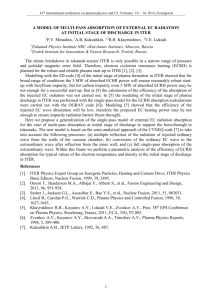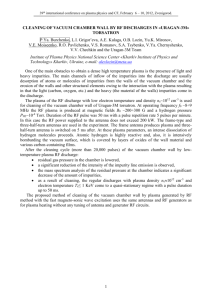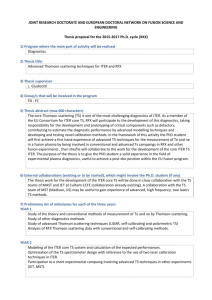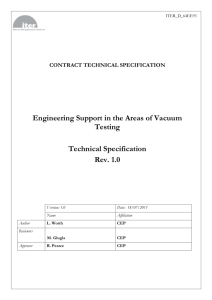Plasma system to clean optical mirrors ITER
advertisement
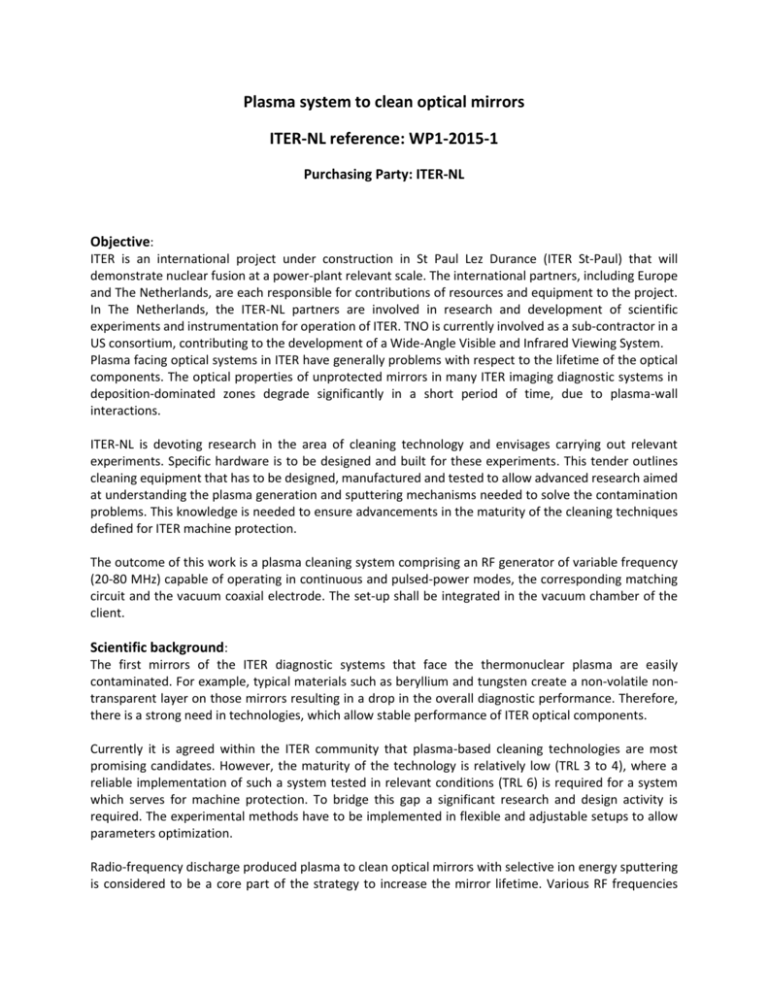
Plasma system to clean optical mirrors ITER-NL reference: WP1-2015-1 Purchasing Party: ITER-NL Objective: ITER is an international project under construction in St Paul Lez Durance (ITER St-Paul) that will demonstrate nuclear fusion at a power-plant relevant scale. The international partners, including Europe and The Netherlands, are each responsible for contributions of resources and equipment to the project. In The Netherlands, the ITER-NL partners are involved in research and development of scientific experiments and instrumentation for operation of ITER. TNO is currently involved as a sub-contractor in a US consortium, contributing to the development of a Wide-Angle Visible and Infrared Viewing System. Plasma facing optical systems in ITER have generally problems with respect to the lifetime of the optical components. The optical properties of unprotected mirrors in many ITER imaging diagnostic systems in deposition-dominated zones degrade significantly in a short period of time, due to plasma-wall interactions. ITER-NL is devoting research in the area of cleaning technology and envisages carrying out relevant experiments. Specific hardware is to be designed and built for these experiments. This tender outlines cleaning equipment that has to be designed, manufactured and tested to allow advanced research aimed at understanding the plasma generation and sputtering mechanisms needed to solve the contamination problems. This knowledge is needed to ensure advancements in the maturity of the cleaning techniques defined for ITER machine protection. The outcome of this work is a plasma cleaning system comprising an RF generator of variable frequency (20-80 MHz) capable of operating in continuous and pulsed-power modes, the corresponding matching circuit and the vacuum coaxial electrode. The set-up shall be integrated in the vacuum chamber of the client. Scientific background: The first mirrors of the ITER diagnostic systems that face the thermonuclear plasma are easily contaminated. For example, typical materials such as beryllium and tungsten create a non-volatile nontransparent layer on those mirrors resulting in a drop in the overall diagnostic performance. Therefore, there is a strong need in technologies, which allow stable performance of ITER optical components. Currently it is agreed within the ITER community that plasma-based cleaning technologies are most promising candidates. However, the maturity of the technology is relatively low (TRL 3 to 4), where a reliable implementation of such a system tested in relevant conditions (TRL 6) is required for a system which serves for machine protection. To bridge this gap a significant research and design activity is required. The experimental methods have to be implemented in flexible and adjustable setups to allow parameters optimization. Radio-frequency discharge produced plasma to clean optical mirrors with selective ion energy sputtering is considered to be a core part of the strategy to increase the mirror lifetime. Various RF frequencies produce ion fluxes with different ion energy distributions in different gases and pressures. Therefore fluxes and ion energies distributions have to be determined in order to effectively remove various potential contaminants. Dutch Industrial Partner The Dutch industrial company that will execute this project will expand his expertise in the selective ion sputtering and surface cleaning as well as in the manufacturing and integration of hardware for RF plasma generation for ITER applications. This will strengthen his position and increase the chances of later being employed in the engineering and fabrication of the cleaning systems to be integrated in the ITER diagnostic port plugs which are currently in the design phase. Activities: The activities are defined in three tasks. The tasks include the design, production, hardware supply and the integration of the whole setup in the vacuum system of the client. After each task an decision moment is to be defined in order to further proceed with the next task. Task 1. Design of the necessary vacuum, RF and electrical parts needed for the plasma system to be assembled on the test setup of the client. The concept specifications are defined in Appendix 1. Appendix 2 presents the set-up concept including the main units to be delivered and purchased. The deliverables of this task are the technical drawings and a succinct report describing the system and the integration plan. Task 2. Manufacturing of the necessary vacuum and electrical components, their assembling on the site of the manufacturer and the acceptance test there. The procurement activities of the commercial available RF hardware (generator and matcher) as presented in Appendix 2 can be started in parallel with Task 1. Task 3. Components delivery, assembling and integration on the test setup of the client including connecting the RF generator, matcher, installing the RF vacuum electrode and acceptance plasma test as defined in Appendix 3. Selection criteria: The requirements below will be considered in the assessment of the proposals. A good understanding of the technical specification and the application The ability to meet the specified requirements Proven experience in manufacturing vacuum and RF hardware components and plasma/vacuum system integration Knowledge and experience in working in a challenging environment such as nuclear fusion, aerospace or semiconductor industry is desirable. The lead time of the project The tender is approved on the basis of the best economic offer The proposal shall include technical, financial and managerial information. The proposal must be based on the ITER-NL purchase conditions. Other conditions will be rejected. The proposal submission dead-line is May 11th, 2015. The proposals shall be submitted at iter-nl@tno.nl. A signed hardcopy of the proposal shall be mailed to: TNO – Locatie Delft Mrs. Oana van der Togt Stieltjesweg 1 2628 CK Delft Tender assessment will be closed on June 1st, 2015. Appendix 1. Main specification for the plasma system Material: stainless steel compatible with cleanroom environment Electrical insulators and vacuum breaks: Al2O3 ceramics grade >99.5% purity RF cables , compatible with matcher and generator Copper materials facing vacuum & plasma – are NOT allowed Feedthrough for the electrode system should fit flange type DN100CF with 100 mm internal diameter Total length inside the vacuum system: 300 mm Maximum electrode diameter inside the vacuum system 150 mm RF generator requirements: variable frequency 20-80 MHz output power at any of the operating frequencies 500 W, pulse power mode should be allowed by the design. Minimum on and off times 50 µs adjustable to continuous Other dimensions see in Appendix 2 Matching system should correspond to the characteristics of the generator Generator control and operation : manual and computer controlled Appendix 2. Conceptual drawing of a cleaning system Appendix 3. Acceptance test conditions The system should operate at the following conditions: variable frequency 20-80 MHz pressure: 1 – 50 Pa Power: 10 -500 W Test time: continuous 8 h Duty cycle: 1-% to 90 % Reflected power: as in the specifications of the commercial matcher
